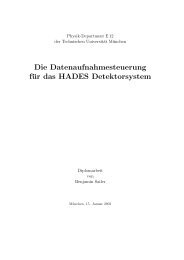Fachbereich Mathematik - GSI
Fachbereich Mathematik - GSI
Fachbereich Mathematik - GSI
Erfolgreiche ePaper selbst erstellen
Machen Sie aus Ihren PDF Publikationen ein blätterbares Flipbook mit unserer einzigartigen Google optimierten e-Paper Software.
Abstract<br />
In the <strong>GSI</strong> therapy pilot project from 1997 until 2008 about 450 cancer patients<br />
were successfully treated with carbon ions. Because of the promising healing rates<br />
the clinical radiotherapy facility HIT was opened in 2009. However, research for the<br />
heavy-ion therapy is still in progress at <strong>GSI</strong>.<br />
For the treatment planning the software TRiP is used. An essential part of the<br />
treatment planning ist the dose optimization. The aim of the dose optimization is<br />
to achieve a homogeneous target dose distribution as close as possible to the prescribed<br />
dose distribution by an appropriate sparing of healthy tissue and critical<br />
structures like the brainstem. These requirements can be mathematically expressed<br />
by an optimization problem, where the free optimization parameters are the particle<br />
numbers for the rasterspots. If biological effects are taken into account, the optimization<br />
problem leads to a nonlinear, finite dimensional and restricted minimization<br />
problem. A theoretical examination and a solution of the optimization problem is<br />
the core area of this master-thesis.<br />
By utilizing a special variant of the Weierstraß extreme value theorem, which<br />
requires the lower semi-continuity and radial unboundness of the objective function,<br />
the existence of a global minimum of the optimization problem can be proofed. Due<br />
to the nonconvexity of the objective funtion the uniqueness of a global minimum<br />
can not be proofed straightforward because standard techniques for such proofs can<br />
not be applied. A numerical approach, which indicates, that the minimum of the<br />
objective function is unique, is discussed. Furthermore, the objective function is<br />
approximated with an appropriate smooth function. This is necessary to derive the<br />
Karush-Kuhn-Tucker-conditions for the optimization problem.<br />
Due to the nonlinearity of the objective function the optimization problem can<br />
only be solved with numerical methods. For this purpose the Linesearch-Techniques<br />
method of steepest descent, conjugated gradients and the inverse BFGS-method were<br />
implemented and examined. Several variants of these numerical solvers are presented<br />
in this work. The convergence results show, that the Fletcher-Reeves variant of<br />
the conjugated gradient method has the best numerical properties. The results of<br />
the inverse BFGS-method are similar concerning the iteration steps but require by<br />
a factor of 1.5 more computation time. The method of steepest descent is slow<br />
concerning the iteration steps and computation time.<br />
The convergence results show, that currently the Fletcher-Reeves variant of the<br />
conjugated gradient method is the best algorithm for the optimization step in the<br />
treatment planning procedure. With this method complete patient plans can be<br />
optimized in an acceptable computation time. Furthermore, this method doesn’t<br />
require much memory space and is robust.<br />
3

















